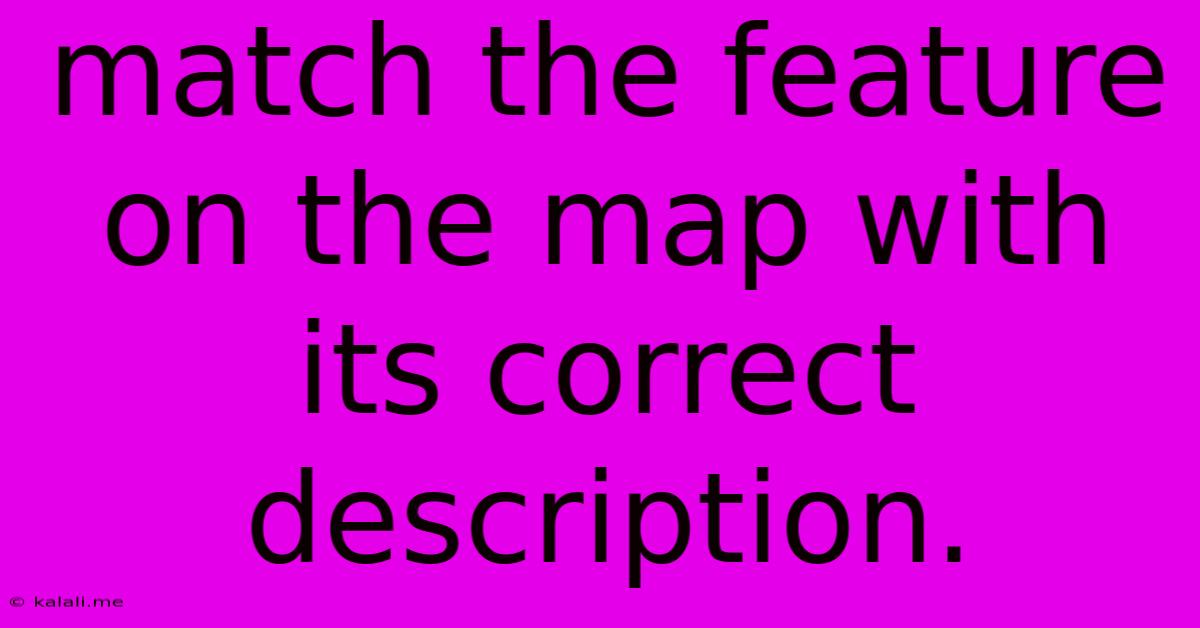Match The Feature On The Map With Its Correct Description.
Kalali
Jun 14, 2025 · 3 min read

Table of Contents
Match the Feature on the Map with its Correct Description: A Guide to Cartographic Literacy
Maps are powerful tools. They condense vast amounts of geographical information into a visually accessible format, allowing us to understand spatial relationships, analyze patterns, and make informed decisions. But to effectively use a map, you need to understand its features and their corresponding descriptions. This article will guide you through identifying and interpreting common map features, improving your cartographic literacy and enhancing your map-reading skills. Understanding these features will help you interpret maps more effectively, whether you're planning a road trip, analyzing geographical data, or simply exploring the world.
Understanding Key Map Features
Maps utilize a variety of symbols and features to represent real-world elements. Successfully matching these features with their descriptions requires a keen eye for detail and a basic understanding of cartographic conventions. Here are some common map features and their typical representations:
1. Points of Interest (POIs): These are locations of specific significance, often represented by symbols or icons. Examples include:
- City/Town: Often shown as a labeled dot or a filled-in circle, sized proportionally to population in some maps.
- Landmark: Represented by unique symbols – a church might be a cross, a park might be a green area with a tree symbol, etc.
- Airport: Typically shown with an airplane symbol.
- Hospital: Often marked with a medical cross or a stylized hospital building icon.
2. Lines: Lines on a map represent various features, including:
- Roads: Usually shown as thin lines, with thicker lines indicating major highways or freeways. Different colors might be used to distinguish road types.
- Rivers/Streams: Typically depicted as blue, winding lines. The thickness might reflect the size of the waterway.
- Railroads: Often represented by parallel lines, sometimes with a distinct symbol.
- Political Boundaries: These lines define the borders between countries, states, or other administrative regions. They are often bold and sometimes dashed or dotted.
3. Areas: These represent geographical regions with shared characteristics.
- Forests: Often shaded green or shown with a pattern of green trees.
- Mountains/Hills: Represented by contour lines (lines of equal elevation) or shaded relief (showing varying levels of elevation through shading). Mountain peaks might be indicated with a specific symbol.
- Lakes/Oceans: Shown as blue areas, sometimes with a different shade to show depth.
- Deserts: Often depicted in tan or light brown.
4. Labels & Text: These are essential for understanding the map's content.
- Place Names: The names of cities, towns, mountains, rivers, etc.
- Scale: A crucial element showing the relationship between the map's distances and real-world distances. Expressed as a ratio (e.g., 1:100,000) or a scale bar.
- Legend/Key: A table explaining the symbols and colors used on the map. This is paramount for accurate interpretation.
- Compass Rose: Indicates direction (North, South, East, West).
Tips for Matching Map Features
- Start with the Legend: Always begin by carefully reviewing the map's legend. This is your key to understanding the symbols used.
- Look for Patterns: Recognize recurring symbols and their consistent representation across the map.
- Consider Context: Use the surrounding features to help you identify ambiguous symbols.
- Use Process of Elimination: If unsure about a particular feature, eliminate unlikely options based on the context and legend.
- Practice: The more you practice reading and interpreting maps, the better you'll become at matching features to their descriptions.
By mastering the art of matching map features to their descriptions, you will significantly enhance your ability to extract information, analyze spatial data, and effectively navigate the world around you. So grab a map, study its features, and start exploring!
Latest Posts
Latest Posts
-
Which Of The Following Is An Example Of A Decomposer
Jun 14, 2025
-
Second Most Abundant Element On Earth
Jun 14, 2025
-
In Which Stage Of Meiosis Crossing Over Takes Place
Jun 14, 2025
-
Which Is Not A Function Of The Cytoskeleton
Jun 14, 2025
-
One Astronomical Unit Is Equal To
Jun 14, 2025
Related Post
Thank you for visiting our website which covers about Match The Feature On The Map With Its Correct Description. . We hope the information provided has been useful to you. Feel free to contact us if you have any questions or need further assistance. See you next time and don't miss to bookmark.